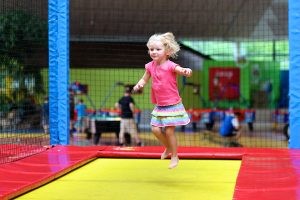Jumping is a significant milestone in a child’s physical development. It signifies a leap in motor skills, coordination, and strength. But when do kids typically learn this exciting skill? This article will explore the developmental stages of jumping in children, highlighting the importance of this activity and providing tips for parents to encourage their little ones.
The Jumping Timeline: From Tentative Hops to Confident Leaps
Most children begin experimenting with jumping between 16 and 18 months old. This often coincides with other developmental milestones like running, climbing, and navigating stairs with assistance.
Initially, toddlers start with rudimentary jumping in place, barely lifting their feet off the ground. Think of it as more of a bouncing motion. As their leg muscles strengthen and their balance improves, they progress to jumping off low objects like a single step or a small stool, always landing on both feet.
Around the age of two, children typically master jumping forward, clearing small distances. Hopping on one foot usually develops later, typically between the ages of three and four, requiring more advanced balance and coordination.
Why Jumping Matters: More Than Just Fun and Games
Jumping isn’t just a playful activity; it plays a crucial role in a child’s overall development:
- Muscle and Bone Strength: Jumping strengthens leg muscles and promotes bone density, laying the foundation for future physical activities. The impact from jumping helps bones grow stronger and denser, reducing the risk of fractures later in life.
- Motor Planning and Sequencing: Jumping requires children to plan and execute a sequence of movements, improving their motor planning skills crucial for navigating their environment. They learn to judge distances, estimate the force needed for the jump, and coordinate their body movements for a successful landing.
- Balance Enhancement: Jumping challenges and refines a child’s sense of balance, contributing to stability and coordination in other activities like running and walking.
- Boosting Overall Health: Jumping is a great form of exercise, contributing to a child’s cardiovascular health and overall well-being. It helps build a foundation for an active lifestyle, combating childhood obesity and promoting lifelong fitness.
- Social Interaction: Jumping is often integrated into children’s games and play, fostering social interaction and cooperation. Confident jumpers are more likely to participate in group activities, developing crucial social skills.
 alt text: A young child jumping on a trampoline with a big smile on their face
alt text: A young child jumping on a trampoline with a big smile on their face
Recognizing Potential Concerns: When to Seek Guidance
While most children develop jumping skills within the expected timeframe, some may experience delays or challenges. Consult a pediatrician or a pediatric physical or occupational therapist if your child:
- Is nearing age three and unable to jump.
- Lacks the leg strength to lift off the ground.
- Frequently falls while attempting to jump.
- Exhibits significant fear or anxiety related to jumping.
- Shows a preference for pushing off with only one leg.
Encouraging Your Child’s Jumping Journey
Parents can actively encourage their child’s jumping development through various activities:
- Provide Opportunities for Practice: Create a safe space for jumping, offering low, soft surfaces like cushions or mats initially. Playgrounds with age-appropriate equipment offer excellent opportunities for practicing jumping skills.
- Engage in Jumping Games: Simple games like hopscotch, jumping jacks (modified for toddlers), or jumping over low objects can make learning fun and engaging.
- Be a Role Model: Jump with your child! Demonstrating different jumping styles and encouraging them to imitate you can make the learning process more interactive.
- Celebrate Small Victories: Positive reinforcement and encouragement go a long way in building your child’s confidence and motivation. Celebrate each milestone, no matter how small.
Conclusion: A Springboard for Development
Learning to jump is a significant developmental milestone that contributes to a child’s physical, cognitive, and social well-being. By understanding the typical progression of jumping skills and providing a supportive environment, parents can help their children confidently leap into this exciting new phase of development. Remember to consult with a healthcare professional if you have any concerns about your child’s progress.
